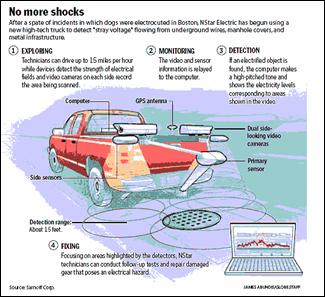NStar's hunt for stray volts
Amid the riskiest season, trucks help find leaks that threaten pets
 By Peter J. Howe, Globe Staff | February 15, 2007
By Peter J. Howe, Globe Staff | February 15, 2007
Tom Zazulak is inching his truck down a South Boston side street when the computer on his dashboard suddenly begins to chirp, then trill like a siren wail.
It's coming up on that time of year again when dogs in Boston are most vulnerable to electrocution. The $100,000-plus worth of sensors on Zazulak's white Nstar Electric pickup truck are warning him that at the corner of C and West Seventh streets one night last week, he may have found another instance of "stray voltage" -- electricity leaking from a lamp pole or damaged underground wire.
Since 2000, stray voltage has been blamed in the deaths of at least four dogs walking along Boston streets. This is the riskiest time of year, when melting snow laden with ice-melting salts creates a conductive brew that turns underground electrical problems that are harmless the rest of the year into potentially fatal, and completely invisible, threats for dogs. Human beings, even toddlers, normally are safe because they're wearing boots or shoes that insulate them.
"Listen to that: It goes way up, and then right back down," says Zazulak, an NStar principal electrical engineer and 40-year company veteran. He's referring to the computerized system that detects electrical fields and shows their strength with a varying-volume signal. Video cameras on either side of the truck, cross-referenced with a satellite-tracking position locator, map the electric signal inch by inch over the streetscape.
Zazulak stops at a corner store. "Something went off right back there at the streetlight. We gotta check that."
Donning a hard hat, Zazulak steps into the wind-whipped 20-degree night and pulls out a voltage-detection wand, a canelike device with a blinking tip that lights up when it finds electrical current. He starts tapping on everything metal. Manhole covers. Catch basins. Street signs. Streetlight bases. A chain-link fence.
Nothing.
"Where is it?" asks an exasperated Zazulak. Then he looks up and sees a cable strung from one streetlight to another. "Aha, there you go," he says.
Somewhere under the sidewalk, the underground line between the lights must have become damaged, so the city spliced a 20-foot stretch of overhead line -- in utility-ese, a "shunt jumper" -- to keep the electricity flowing. It's no hazard to any pedestrian, but it's emitting enough of an electric field to set off the detectors.
"I feel good now," Zazulak says as he resumes his crawl down the Southie streets.
For over two years, NStar and city technicians have been at work checking tens of thousands of pieces of infrastructure for electrical charges. Stray voltage can occur when underground cables corrode or are cut open. Even when problems are fixed, they can recur if a repair or cable seal fails.
But after the fourth dog electrocution in six years last winter, when six-year-old Labrador mix Killian stepped on a Charlestown metal street plate that a damaged underground line had energized, NStar and city and state officials finally concluded they needed a high-tech solution and brought in the stray-voltage truck from Sarnoff Corp. of Princeton, N.J. Instead of human inspectors walking block by block looking for stray voltage, technicians can cover several times more ground by rolling the truck down city streets, getting out to check when the alarm is tripped.
Since last March, NStar workers in the truck and on foot have checked out 53,000 pieces of equipment. Of 68 problems found and fixed -- none of them life-threatening -- 63 were ferreted out using the truck. Almost all were streetlights and their control boxes, although Zazulak found a Dorchester Avenue street sign that nicked an underground cable when it was installed and was emitting 40 volts.
The NStar truck has surveyed 2,300 miles in neighborhoods with underground lines, many blocks more than once. There have been no reported dog electrocutions since NStar began using the truck.
James W. Hunt III , Mayor Thomas M. Menino's top energy aide, said that over the past year, city public works employees have also installed more than 24,800 insulating devices made of recycled plastic, called "pull box inserts," to stop stray voltage in streetlight bases.
Hunt called the truck "an innovative technology that's a big part of the multipronged approach we've been taking. I think the city has the most effective stray-voltage-prevention program of any city in the country." Still, "we also acknowledge that on any given day, an accident can happen," he said.
Given past dog electrocutions, the Massachusetts Society for the Prevention of Cruelty to Animals has come to urge all city dog owners outfit them with rubber-soled booties when walking in snow or slush, both to protect them from salt and sand but also stray voltage.
"We'd have to wait and see what progress this truck makes, but we're definitely happy that NStar seems to be taking this quite seriously," said a society spokesman, Brian Adams .
For a Hub dog owner who endured the horror of watching her pet die, there's no excuse for NStar, the city, and other responsible officials not to make every effort to fix the problem.
"The truck might be good for public relations, but our streets are still not protected by regulations to prevent shabby construction," said Monica Ponce de Leon , a Harvard University architecture professor whose dog Laszlo died in 2000 after stepping on a South End manhole cover that had been electrified, apparently by a city public works crew that secured underground cables improperly.
She's since had two children and has two other dogs, but said, "I lament that my children will not know Laszlo. I miss Laszlo. I loved him dearly."
Peter J. Howe can be reached at howe@globe.com.
This article is from the Boston Globe: http://www.boston.com/business/articles/2007/02/15/nstars_hunt_for_stray_volts/?rss_id=Boston+Globe+--+Business+News